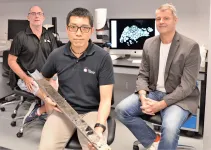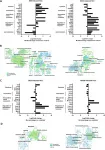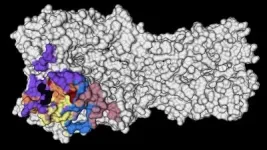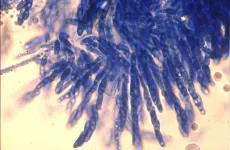(Press-News.org) Climate scientists at the Nanyang Technological University, Singapore (NTU, Singapore) have extended the known record of Singapore's sea-level to almost 10,000 years ago, providing a more robust dataset to aid future predictions of sea-level rise.
One of the main challenges in researching climate change is to reconstruct its history over thousands of years. To have a better sense of the potential causes and effects of future changes, scientists need to learn from and understand the past.
Extracting ancient sediments from a depth of up to 40 m underground at a site at Singapore's Marina South, an international team led by NTU researchers put the samples through rigorous laboratory methods (e.g., identifying microfossils such as foraminifera) and statistical analysis to obtain data to reconstruct Singapore's sea level history.
For climate scientists, the further the sea-level record goes back in time, the clearer the picture can be for future predictions. The transition at the beginning of the Holocene (10,000-7,000 years ago) represented the last major episode of natural global warming in Earth's history, when melting ice sheets and warming oceans led to a 20 m rise in sea level. For the last 3,000 years, the sea level in Singapore had been stable, before the recent acceleration in the 20th century due to climate change.
Lead author, Dr Stephen Chua, who completed the study as part of his doctoral work at the Earth Observatory of Singapore (EOS) and Asian School of the Environment (ASE) at NTU Singapore said, "By dating the Singapore sea-level record to 10,000 years ago, we retrieved crucial new information from the early Holocene period. This is a period that is characterised by rapid sea-level rise yet remains poorly understood - until now."
"This more refined sea-level record also has wider implications. For instance, it would lead to more robust and accurate local projection of sea-level rise, offering a strategic guide for Singapore as it moves to adapt to climate change."
Professor Maureen Raymo, Co-Founding Dean of the Columbia Climate School at Columbia University, who was not involved in the study, said: "This is the type of crucial information needed to effectively plan adaptation measures in the face of ongoing sea level rise due to global warming. Our past does inform our future."
Why Marina South site for investigations?
Developing an accurate ancient sea-level record required sediment extraction from an 'ideal' site where deposits such as marine mud and mangrove peats are present.
To pick the best possible coring site for accurate results, researchers looked through thousands of available borehole logs - records of holes that have been drilled into the ground for infrastructure projects.
Associate Professor Adam Switzer who leads the Coastal Lab at ASE and EOS and who was Dr Chua's supervisor, said, "Finding the right place to drill was a huge effort. Stephen spent well over a year going over old borehole information from a variety of construction efforts over the last 30 years just to find records that might be suitable. As a result, our understanding of the geology of the whole area has also dramatically improved."
Findings useful for Singapore's coastal defence plan against rising sea levels
The study, published in the peer-reviewed journal The Holocene on 4 June 2021, also found the first conclusive evidence that mangroves only existed in the Marina South area for around 300 years before succumbing to flooding associated with rising sea level at the time.
At a depth of 20 m below modern sea level, researchers found abundant mangrove pollen indicating that a mangrove shoreline existed in southern Singapore almost 10,000 years ago. The NTU findings reveal that sea-level rise during that time was as high as 10 - 15 mm per year which likely led to the mangrove's demise.
The findings provide Singapore with useful insights for current and future adaption methods as the island nation looks to go beyond engineering solutions and to incorporate natural methods to safeguard the country's coastlines.
Despite its adaptability and effectiveness as a coastal defence, the study highlights the limitations of mangroves in the event of rapid sea-level rise. This confirms an earlier study co-authored by NTU showing that mangroves will not survive if sea-level rise goes beyond 7 mm per year under a high carbon emissions scenario.
Co-author of the study, Professor Benjamin Horton, Director of EOS, said, "Sea-level rise is a potentially disastrous outcome of climate change, as rising temperatures melt ice sheets and warm ocean waters. Scenarios of future rise are dependent upon understanding the response of sea level to climate changes. Accurate estimates of past sea-level variability in Singapore provide a context for such projections".
Providing an independent comment on the research, Professor Philip Gibbard, a Quaternary geologist from the Scott Polar Research Institute at the University of Cambridge, underscored the importance of records from localities distant from the glaciated regions such as Singapore.
"They offer a model of the process of sea-level change uncomplicated by factors associated with deglaciation, meltwater discharge and more. This important systematic contribution from Singapore and the region provides a valuable record that spans the post-glacial Holocene period, thus allowing a general pattern of sea-level change in the region to be established. This record can then be further refined as more studies become available in the future."
INFORMATION:
Bottom Line: The majority of surveyed Americans had an inadequate understanding of palliative care, and frequency of health care utilization was one determinant of knowledge.
Journal in Which the Study was Published: Cancer Epidemiology, Biomarkers & Prevention, a journal of the American Association for Cancer Research
Author: Motolani Ogunsanya, PhD, an assistant professor at The University of Oklahoma Health Sciences Center
Background: Palliative care aims to improve the quality of life for patients and caretakers by addressing the physical, psychological, and logistical challenges associated with a disease or its treatment. In contrast to hospice, which provides comfort care for patients who have stopped treatment and are near the end of life, palliative care serves as an ...
Oncotarget published "Characterization of the inflammatory microenvironment and hepatic macrophage subsets in experimental hepatocellular carcinoma models" which reported that HCC typically develops on a background of chronic inflammation and fibrosis with tumor associated macrophages playing an important role in chronic inflammation-induced HCC and progression.
However, the liver harbors unique macrophages, resident liver Kupffer cells and monocyte-derived macrophages, and their contribution to HCC and to the population of TAMs is incompletely known.
Here, the authors characterized the tumor microenvironment and the proportion and transcriptional profile of ...
A growing number of people use they/them pronouns to signal their gender identity, but for many people, use of "they" to refer to a single individual takes some getting used to.
Results of a recent END ...
Lauren Dreier was paging through a 19th century book by the German architect Gottfried Semper when she spotted some intriguing patterns inspired by lace. A professional artist and designer who often incorporates technology into her work, Dreier, who is also a doctoral student at the School of Architecture at Princeton University, decided to recreate the printed illustrations in 3D.
She grabbed ribbon-like plastic material she had been experimenting with in her studio, bending and connecting the semi-rigid strips. To Dreier's surprise, the structure she built assumed a bumpy geometry, with four distinct hills and valleys. "I thought it would make a dome, but it was this unusual shape," Dreier said. Curious to know what caused ...
A new study from the University of Chicago and Scripps Research Institute shows that during the last great pandemic--2009's H1N1 influenza pandemic--people developed strong, effective immune responses to stable, conserved parts of the virus. This suggests a strategy for developing universal flu vaccines that are designed to generate those same responses, instead of targeting parts of the virus that tend to evolve rapidly and require a new vaccine every year.
Influenza is an elusive and frustrating target for vaccines. There are two main types of flu virus that can infect humans, which evolve rapidly from season to season. ...
Neurological and psychiatric symptoms such as fatigue and depression are common among people with Covid-19 and may be just as likely in people with mild cases, according to a new review study led by a UCL researcher.
By reviewing evidence from 215 studies of Covid-19, the meta-analysis published in the Journal of Neurology, Neurosurgery and Psychiatry reports a wide range of ways that Covid-19 can affect mental health and the brain.
Lead author Dr Jonathan Rogers (UCL Psychiatry and South London and Maudsley NHS Foundation Trust) said: "We had expected that neurological and psychiatric symptoms would be ...
Researchers have re-animated specimens of a fungus that causes coffee wilt to discover how the disease evolved and how its spread can be prevented.
Coffee Wilt Disease is caused by a fungus that has led to devastating outbreaks since the 1920s in sub-Saharan Africa, and currently affects two of Africa's most popular coffee varieties: Arabica and Robusta.
The new research shows that the fungus likely boosted its ability to infect coffee plants by acquiring genes from a closely related fungus, which causes wilt disease on a wide range of crops, including ...
Sea ice in the coastal regions of the Arctic may be thinning up to twice as fast as previously thought, according to a new modelling study led by UCL researchers.
Sea ice thickness is inferred by measuring the height of the ice above the water, and this measurement is distorted by snow weighing the ice floe down. Scientists adjust for this using a map of snow depth in the Arctic that is decades out of date and does not account for climate change.
In the new study, published in the journal The Cryosphere, researchers swapped this map for the results of a new computer model designed to estimate snow depth as it varies year to year, and concluded that sea ice in key ...
Concerns about side effects and whether vaccines have been through enough testing are holding people back from getting vaccinated against COVID-19, according to a new report.
Data from an international survey of 15 countries* which ran between March and May this year showed that these were the most commonly cited reasons for not having had a coronavirus vaccine yet, in addition to not being eligible for one. Respondents' other commonly reported reasons included concerns about not getting the vaccine they would prefer, and worries over whether the vaccines are effective enough.
Led by Imperial College London's Institute of Global Health Innovation in collaboration with YouGov, the survey also looked at trust in COVID-19 vaccines. ...
A University of Birmingham-led study funded by the UK Coronavirus Immunology Consortium has found that many patients with COVID-19 produce immune responses against their body's own tissues or organs.
COVID-19 has been associated with a variety of unexpected symptoms, both at the time of infection and for many months afterwards. It is not fully understand what causes these symptoms, but one of the possibilities is that COVID-19 is triggering an autoimmune process where the immune system is misdirected to attack itself.
The study, published today (June 4) in the journal Clinical & Experimental Immunology, investigated the frequency and types of common ...




